Last week I was in Colombia attending the first fermentation workshop run by Lucia Solis, a coffee processing consultant who I’ve been following for nearly 3 years since she launched her podcast series. I also support her via Patreon which gives me access to additional content such as research papers and videos. When Lucia announced the signup dates of the workshop to her Patreon supporters I jumped straight in.

The course was held at an eco-glamping resort just outside of Santuario in the Risaralda department, a major coffee growing region. The attendees included producers from Colombia and Kenya, a Colombian green exporter (who we already buy coffee from), roasters and green buyers from the US and Switzerland (and the UK obvs), baristas from Dubai and Australia and Hawaii, a travelling content writer for Barista Hustle (amongst other places) and a construction businessman from Kona just about to take the big step and start his coffee career. Alongside that were the ‘management’, Lucia and her partner Nick, Francy and two additional staff recording every moment of the 4 day course. A processing course needs a few key ingredients, freshly harvested coffee cherry and access to a mill (beneficio) with a number of features: dehuller/depulper, large containers for fermentation, water, drying beds and of course an amenable owner and staff willing to help and guide a fairly amateur group through various processes under Lucia’s instructions.
My Colombian coffee adventure started one day earlier than the course since I’d arranged a visit to one of the producers we’ve been buying small amounts of exceptional coffees from for the last two years, Sebastian Ramirez and his farm El Placer. I was joined on the visit by my Swiss course companion Christian, a smiling fire ball of energy and knowledge, and of course fluent in numerous languages. We were picked up from our apartment in Pereira and the driver took us to a small village Filandia where we met Sebastian and his beautiful Australian cattle dog Niña. A vibrant and immaculately cared for village with the main square closed off to traffic for a Sunday fair with music, dancing, food and other vendors. Sebastian then took us to his favourite restaurant and treated us to a delicious lunch before he then drove us another hour to his farm El Placer. The landscape on the journey was stunning and the roads progressively more rugged (luckily Niña let me share her back seat in the car and made me feel very welcome). On arrival Sebastian showed us the wet processing (wet mill) facility and the massive greenhouse style drying patios which were full with parchment.
 |
 |
 |
 |
Then we went to the cupping room for treat time. We tasted his exotic processes and varieties including Gesha, Wush-Wush and Pink Bourbon. All delicious and expect to see some more of Sebastians coffees on our site soon. One of the things I’ve found so humbling in the last couple of years of being more ‘connected’ to the producers we’ve been buying from (directly or through import partners) is that even though we might be buying very small amounts of their coffees, our support seems to mean an awful lot. I gave a bag of one of Sebastian's coffees to him and he was thrilled and showed me his small collection of bags from roasters across the world including our special ‘process pack’ we launched just before Christmas 2021 which was sitting in pride of place.
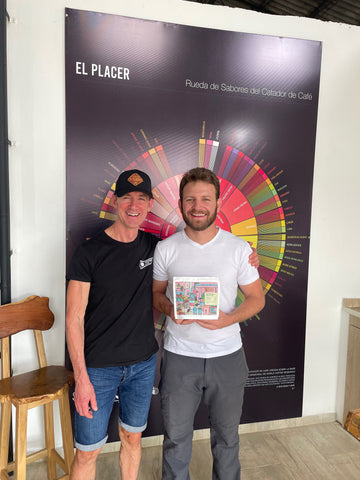
As we were about to leave the sky turned very dark and the heavens opened. Sebastian said that the rains in the last few years had become heavier and more frequent than previously and were causing a number of problems including stress and damage to the coffee trees. When we went back into the patios we could quickly see the damage that the previous days storm had done. A number of the glass panels were broken and dislodged and rain was coming in and onto the parchment coffee. I could sense Sebastian's stress and he said that the storm was massive and had caused significant damage to not only the glass house but also the roof of the mill and various other parts of the beneficio. Then he pointed out the damage to the large Plantain trees mixed amongst the coffee trees. On one side of the valley the trees were snapped in two or felled completely and had fallen onto the coffee trees. The storm had done devastating damage and yet Sebastian had taken the day to host us rather than getting on and doing what was needed. Another very humbling moment.
A few of the other course attendees had arrived in Periera so we got together for a pre-workshop meal and shared each others backgrounds which were as diverse as the cultural mix. Right away you could tell it was going to be a great few days together and a lot of fun.
Then the course started proper..

First up was meeting Lucia, Nick and the rest of the team and then a brief intro into the week ahead with a mix of hands-on processing sessions, class sessions, a farm visit and lots of data recording. Lucia sounds just the same in real life as she does on her podcast or discord sessions. A wealth of knowledge and an easy going approach with a bottomless pit of fitting metaphors making her a great educator. After lunch and the intro we headed across the road to the beneficio where the coffee cherries were being delivered.
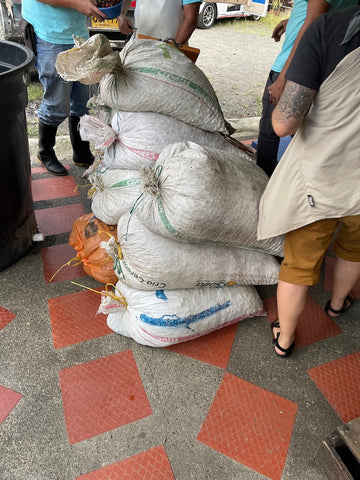 |
 |
 |
 |
Beneficio Alto Nieblas was a 3 minute walk from our glamp-site and was a beautifully converted 100 year old building which had previous been a roadside restaurant. The owner Ricardo, and all the staff, especially Brian and Sebastian were incredibly welcoming and generous with their time, expertise and patience.

|
 |
 |
 |
It was clear to see that the quality of the cherry was pretty poor, with lots of green unripe cherries, some nice pink cherry and lots of black raisin like over-ripe cherries of all different sizes. Lucia had ordered 1000Kg of cherry to be delivered and it was easy to see we were way away from that target. In the end 440kg cherry was delivered, which was given a very basic wash in a large plastic tank and then scooped out and laid on 3 raised beds for sorting. To get an estimate of the quality /ripeness of the greens Lucia used a 10 x 10 wooden tablet with semi-circular recesses and a sample was taken from the received cherries and placed in order of ripeness, from, green (unripe), through to green with a slight reddy pink hue (under ripe), onto pink/red (ripe) and then dark red and black (over ripe). From this she was able to get a good estimate of the overall ripeness quality of the received cherries and was able to get an estimate of the available sugar content using a Brix TDS meter. This meter became one of our best friends during the week.
 |
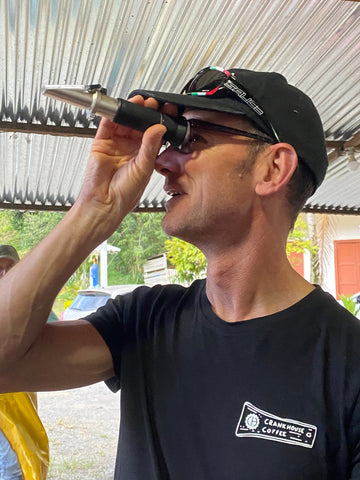 |
Our coffee comprised of approx 6% green, 44% ripe and 50% over-ripe. Lucia explained that in her opinion the under-ripes could be usable in the fermentation but the over-ripes were not. That’s 50% of the total cherry count already gone. It wouldn’t be wasted but it wasn’t useful for the class fermentation since the sugars in the mucilage had already been broken down and consumed by micro-organisms which had likely already imparted an off flavour into the seeds. The over-ripes would be sold into the commodity market. The under-ripes were a different story. Even though the sugar content in those would be lower than the ripes they would still offer some energy source to the yeasts for fermentation and in small amounts could be seen to add certain positive flavour characteristics in the cup. BUT the difficulty with these would be the de-pulper since it wouldn’t be able to remove the seed from the cherry, so they had to go too. We measured the BRIX reading of a few of the ripe cherries and recorded a value of 16%.
Our first task was to sort these over-ripes and greens from the usable ripes… manually.

It was a painstakingly tedious job and we probably got 30% of the way through before Lucia called time at 8pm. In the normal functioning of a beneficio the coffee would have to be sorted and de-pulped immediately on arrival and then placed in the tanks etc. Luckily the beneficio staff finished our job for us (probably in a tenth of the time it would have taken us) whilst we went off for our first group dinner. We left it with a mish-mash of greens, over-ripes and ripes on the sorting tables and returned on Tuesday morning to neat trays of red ripe cherries. That’s how the pros do it.
 |
 |
The next task was to remove the skin of the cherries, which was done via a mechanical de-pulper. The cherry is passed through two rotating disks set at a certain distance that squeeze the cherry as it passes through hopefully separating the skin from the sticky mucilage covered seed. This process also required a lot of human intervention to sort the skins that passed still connected to the seed. Another lengthy laborious process which we all took turns in helping with. The mucilage covered seeds were then submerged in water and it was time to start our 3 processes/fermentations:
- Citric process
- Lactic fermentation
- Yeast fermentation
We split the depulped coffee into 3, one large container for the yeast ferment and two smaller 8Kg buckets for the Citric and Lactic.
The Citric process was simply an addition of lemon juice (which we squeezed ourselves), picked from Lucia’s garden. The principal was to create a highly acidic environment which would break down the pectin chains holding the mucilage onto the seed as quickly as possible to simulate a fully washed process. On a large scale a mechanical demucilagenator could be used but these are expensive pieces of machinery and are very water hungry. Lemons and citric acid are relatively readily accessible.
The Lactic process was an addition of non-iodised salt to create a 2% saline solution and Lucia likes to use her party metaphor. Imagine you’re having a party and you only want to invite Lactobacillus. They tolerate a saline environment and most other microbes do not. The salt is the bouncer.
The main show was the yeast inoculation using a commercial yeast strain from the Saccharomyces cerevisiae family cultivated by LalCafe specifically for coffee fermentations. The Briosa dried yeast was firstly rehydrated and activated by adding to warm water (approx 37C) and waiting for 20mins. It immediately came to life, bubbling and creating a thick aerated head. Then once cooled sufficiently so as not to shock the yeast (diving into an ice cold lake metaphor) it was ready to add to the large tank of pulped coffee, stirred, covered with a plastic sheet and left. Lucia’s prior experience with this yeast indicated 36-72hr fermentation was enough time to impart desirable flavours into the seed.
 |
 |
We recorded certain key data for each of the 3 tanks at this point: pH, Brix, and temperature, and continued to do this as the processes and fermentations continued, to monitor the developments and activity.
Our starting values for each process were:
- Citric: pH3.1, Brix 10.4%, temp 24.2C
- Lactic: pH3.8, Brix 11%, temp 24.7C
- Yeast: pH4.6, Brix 8%, temp 24.2C
Lunch, lectures and then a remeasure after 5 hours and a feel of the slimy pulped mass (for the Citric and Yeast) told Lucia that the Citric process was done. It had a thick gel-like consistency but the beans were dry and chalky when rubbed together indicating that the mucilage had been removed. SUCCESS. The yeast process was already starting to show activity with evident gas bubbles (CO2) under the plastic cover, a sweet rich aroma and changing salient data points.
- Citric : FINISHED (washed and taken to drying beds)
- Lactic: pH4.7, Brix 10.5%, temp 24.9C
- Yeast: pH4.2, Brix 7%, temp 26.1C
 |
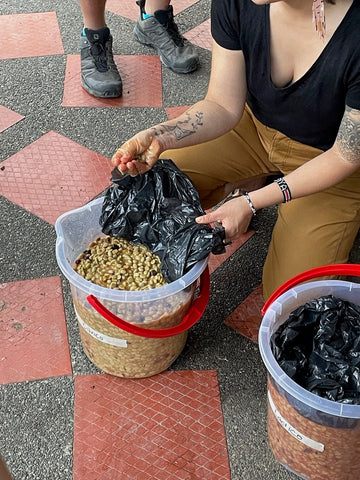 |
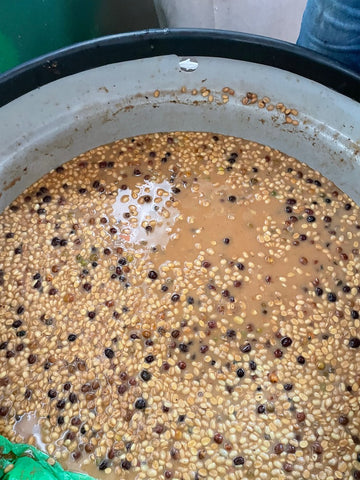 |
 |
Clearly a change in 5 hours for the yeast process. The little beauties were getting busy with consuming the sugars in the mucilage and generating their yeast farts (CO2, esters, acids, alcohols, glycerol, polysaccharides) and heat ! The Lacto ferment was not showing any early signs of activity but Lucia wasn’t concerned since this was typically a much slower process (4-6 days).
We remeasured both the Lactic and the Yeast ferments over the following few days, in between lectures and a farm visit and by day 3 (45 hrs after the ferments were started) these were the figures:
- Lactic: pH4.7, Brix 9, temp 24.5C
- Yeast: pH4.1, Brix 3, temp 25.1C
Not any noticeable change in the Lactic data and Lucia was a little disappointed but not too surprised. The process relied on the native lactobacillus microbes in the environment, on and in the coffee cherries to be present in sufficient numbers that they would be able to kick-start a fermentation process. It seems they were a little sleepy and even though we could see some CO2 bubbles starting to appear, it was a very slow process. Lucia had confidence given a few more days it would gain momentum. She did say that it would be possible to help this fermentation along by carefully increasing its temperature, or by adding a dose of lacto-bacillus. The latter would be very expensive and not readily accessible to most producers. Storage and transport of live bacteria is difficult and expensive compared to dried yeast.
The Yeast process was done - a bubbling mass of energy and clearly the reduced Brix % showed that a significant amount of the sugars had been consumed by the yeast population and the reduced pH showed the increased acidity in the tank from the fermentation process. Another check was to grab a handful of the seeds in the liquid and rub them together. Just like the citric process they were dry and chalky. It was ready to be washed and laid out for drying.

|
 |
Given the short amount of time for the course it wasn’t possible to taste our 3 processes side by side there and then. But like any good demonstration chef Lucia had prepared some earlier. Of course these weren’t the same identical cherries as the ones we were working with but they were of a similar quality and perfect for comparison purposes.
For a few of the people on the course it was the first time they had ever cupped coffee, so it was interesting to see how they got on. There were 4 coffees to cup in total for the comparison, the 3 processes on the low quality cherry similar to what we had worked with and a yeast process applied to a higher quality cherry, a Pink Bourbon.

|
 |
 |
 |
Over the years I’ve tended to think about colours when trying to describe coffees (without thinking too much beyond that as an initial impression) ie. what colour does this remind me of . These were my colours:
- Citric - Brown
- Lactic - Yellow
- Yeast - Red
- Yeast (Pink Bourbon) - Pink
For someone who is used to tasting speciality coffee day in day out it’s quite noticeable when a low quality coffee is put in front of you. The lower quality coffees aren’t balanced with their acidity and sweetness. The acidity might be high but it’s not a pleasant acidity and can be quite harsh and astringent. This could easily be attributed to the poor fruit quality and the fact that a portion of the cherries were not ripe when harvested. Likewise with the sweetness. It might be there but it’s not clean and rounded.
The Citric process (mimicking a fully washed process) showed the true nature of the picked cherries. A little harsh and astringent with some sweetness but not particularly pleasant or balanced. I scored this a 79 (80 at best). The Lactic was a step up for me with some yellow fruit notes and a more pleasant acidity as well as a softer mouthfeel. I scored this an 81-82. I was hoping the Yeast process was going to be a step up again and there were definitely more intense red fruit notes but I did feel it wasn’t as balanced as the Lactic. I scored this 81.
The best cup was of course the yeast fermented Pink Bourbon. Sweet and well balanced with some tropical fruit notes. Very nice - perhaps an 86 or 87. It was interesting drawing this comparison with the low and high quality fruit with the same process applied.
In our debriefing for the processes and our cupping findings Lucia explained that these ‘basic’ processes were not going to make a low quality low grade coffee into a super speciality 90 point coffee. They might be able to elevate the point score slightly and make more interesting profiles but they couldn’t change the innate nature and quality of the coffee that is used as the starting material for the fermentations. Just like the old adage that you cannot make a silk purse out of a sow’s ear !
Improving the starting ingredients with better quality fruit would potentially allow for more improvement and this is really where Lucia places her emphasis when consulting with producers. These types of fermentations cannot fix poor farming practices, but it can be used to help with consistency and offer alternative cup profiles.
There are always exceptions of course. If you’ve been buying from us for a while you’ll know that we’ve had numerous ‘special’ process coffees over the last few years. Two in particular that use very sophisticated processing and fermentation techniques to impart incredibly complex and unusual flavour components into their coffees. Lucia went some way into breaking down these processes in a step by step fashion. The first thing they do is a cleaning process to remove any ambient microbes using OZONE (I thought OZONE was a layer in the atmosphere). I don’t pretend to understand the chemistry but OZONE is O3 and is very unstable and difficult to generate (thank you Tom and Lucia for explaining some basic chemistry). It’s a very expensive process and requires specific laboratory style equipment. The same producers use UV light as another cleaning process at another stage of the fermentation, again not a cheap readily accessible option. Every step in their sophisticated process is carefully managed and controlled, from initial washing all the way through to drying in a dedicated purpose designed and built machine that performs controlled temperature and dehumidification to facilitate a precise drying protocol. The results speak for themselves, amazing coffees from some of the most forward thinking progressive producers in the world. These are the coffees at the 90 point end of the scale. The investment in equipment and knowledge is immense and clearly not accessible to a majority of coffee producers.
The whole workshop was an incredible learning experience made all the more special by the people that I shared it with. Lucia’s style encouraged questions and open discussions at every stage and she was never without one of her metaphors to help get across some difficult bio-chemical concepts. As well as the hands-on and class session we had one farm visit to Finca El Tesorito up some very steep tracks. A small farm that had only recently started selling into the specialty market that had Castillo and Colombia trees planted together and a small newly planted plot of Gesha. They had their own small beneficio on site and had invested in a modern de-huller and sorter as well as a coffee roaster (that they were very proud to show us in operation).

|
 |
 |
 |
 |
 |
So many take homes. I will be working on buying coffees from the three producers on the camp, Carolina and Rubiela from Colombia and Rosebella from Kenya. Cat from CATA exports has kindly offered to help me do so and hopefully you’ll see coffees appear from each of these in the coming months.

An incredible group of people and I feel privileged to have spent the week learning and sharing with them.

Then there were the camp fires at night, but I’ll keep those memories for myself. They were the special ones with special people.
================
Dave - 28/7/2022
